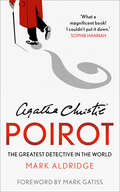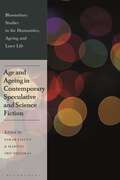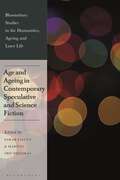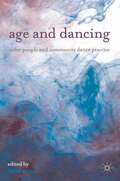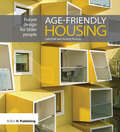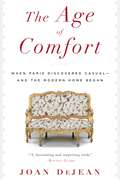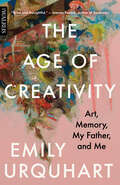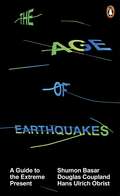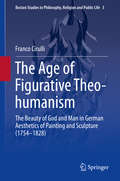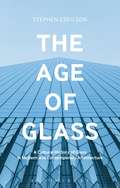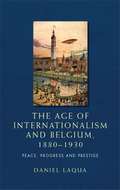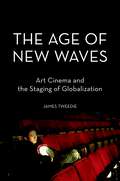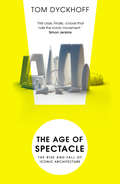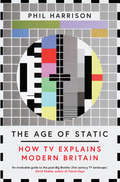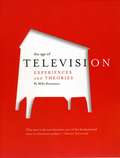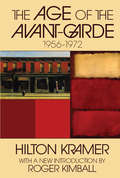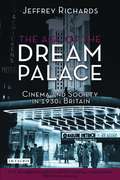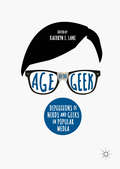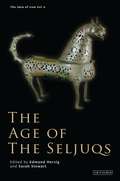- Table View
- List View
Agatha Christie’s Poirot: The Greatest Detective In The World
by Mark AldridgeFrom the very first book publication in 1920 to the film release of Death on the Nile in December 2020, this investigation into Agatha Christie’s Hercule Poirot celebrates a century of probably the world’s favourite fictional detective.
Age and Ageing in Contemporary Speculative and Science Fiction (Bloomsbury Studies in the Humanities, Ageing and Later Life)
by Sarah Falcus and Maricel Oró-PiquerasFocusing on the contemporary period, this book brings together critical age studies and contemporary science fiction to establish the centrality of age and ageing in dystopian, speculative and science-fiction imaginaries. Analysing texts from Europe, North America and South Asia, as well as television programmes and films, the contributions range from essays which establish genre-based trends in the representation of age and ageing, to very focused studies of particular texts and concerns. As a whole, the volume probes the relationship between speculative/science fiction and our understanding of what it is to be a human in time: the time of our own lives and the times of both the past and the future.
Age and Ageing in Contemporary Speculative and Science Fiction (Bloomsbury Studies in the Humanities, Ageing and Later Life)
Focusing on the contemporary period, this book brings together critical age studies and contemporary science fiction to establish the centrality of age and ageing in dystopian, speculative and science-fiction imaginaries. Analysing texts from Europe, North America and South Asia, as well as television programmes and films, the contributions range from essays which establish genre-based trends in the representation of age and ageing, to very focused studies of particular texts and concerns. As a whole, the volume probes the relationship between speculative/science fiction and our understanding of what it is to be a human in time: the time of our own lives and the times of both the past and the future.
Age and Dancing: Older People and Community Dance Practice
by Diane AmansThis highly readable introduction to dance with older people combines key debates and issues in the field with practical guidance, as well as a resources section including numerous 'toolkit materials'. Diane Amans, leading practitioner in Community Dance, provides the ideal beginners' guide for students, practitioners and dance artists alike.
Age-friendly Housing
by Julia Park Jeremy PorteousThis book embeds the principles of how we should approach the design of future housing for an ageing population, reminding us that this is not about ‘other people’, but about each of us. This book focuses on anticipating the needs and aspirations of the next generation of older people, and touches on what this implies for our communities, our towns and our cities, as well as for our living spaces. It will look at how well-designed buildings can facilitate the provision of care, support independence and wellbeing while providing companionship and stimulation. It will also examine how to ensure that buildings remain flexible over a long life. Dealing mainly with new-build, but with a section on adaptation and refurbishment, this book sets out the underlying design principles that should be applied and the early decisions that must be taken.
Age-friendly Housing
by Julia Park Jeremy PorteousThis book embeds the principles of how we should approach the design of future housing for an ageing population, reminding us that this is not about ‘other people’, but about each of us. This book focuses on anticipating the needs and aspirations of the next generation of older people, and touches on what this implies for our communities, our towns and our cities, as well as for our living spaces. It will look at how well-designed buildings can facilitate the provision of care, support independence and wellbeing while providing companionship and stimulation. It will also examine how to ensure that buildings remain flexible over a long life. Dealing mainly with new-build, but with a section on adaptation and refurbishment, this book sets out the underlying design principles that should be applied and the early decisions that must be taken.
The Age of Comfort: When Paris Discovered Casual--and the Modern Home Began
by Joan DeJeanToday, it is difficult to imagine a living room without a sofa. When the first sofas on record were delivered in seventeenth-century France, the result was a radical reinvention of interior space. Symptomatic of a new age of casualness and comfort, the sofa ushered in an era known as the golden age of conversation; as the first piece of furniture designed for two, it was also considered an invitation to seduction. With the sofa came many other changes in interior space we now take for granted: private bedrooms, bathrooms, and the original living rooms. None of this could have happened without a colorful cast of visionaries-legendary architects, the first interior designers, and the women who shaped the tastes of two successive kings of France: Louis XIV's mistress Madame de Maintenon and Louis XV's mistress Madame de Pompadour. Their revolutionary ideas would have a direct influence on realms outside the home, from clothing to literature and gender relations, changing the way people lived and related to one another for the foreseeable future.
The Age of Creativity: Art, Memory, My Father, and Me
by Emily UrquhartA moving portrait of a father and daughter relationship and a case for late-stage creativity from Emily Urquhart, the bestselling author of Beyond the Pale: Folklore, Family, and the Mystery of Our Hidden Genes. “The fundamental misunderstanding of our time is that we belong to one age group or another. We all grow old. There is no us and them. There was only ever an us.” — from The Age of CreativityIt has long been thought that artistic output declines in old age. When Emily Urquhart and her family celebrated the eightieth birthday of her father, the illustrious painter Tony Urquhart, she found it remarkable that, although his pace had slowed, he was continuing his daily art practice of drawing, painting, and constructing large-scale sculptures, and was even innovating his style. Was he defying the odds, or is it possible that some assumptions about the elderly are flat-out wrong? After all, many well-known visual artists completed their best work in the last decade of their lives, Turner, Monet, and Cézanne among them. With the eye of a memoirist and the curiosity of a journalist, Urquhart began an investigation into late-stage creativity, asking: Is it possible that our best work is ahead of us? Is there an expiry date on creativity? Do we ever really know when we’ve done anything for the last time?The Age of Creativity is a graceful, intimate blend of research on ageing and creativity, including on progressive senior-led organizations, such as a home for elderly theatre performers and a gallery in New York City that only represents artists over sixty, and her experiences living and travelling with her father. Emily Urquhart reveals how creative work, both amateur and professional, sustains people in the third act of their lives, and tells a new story about the possibilities of elder-hood.
The Age of Earthquakes: A Guide to the Extreme Present
by Douglas Coupland Hans Ulrich Obrist Shumon BasarPlanet Earth needs a self-help book, and this is itThe future is happening to us far faster than we thought it would and this book explains whyFifty years after Marshall McLuhan's ground breaking book on the influence of technology on culture The Medium is the Massage, Shumon Basar, Douglas Coupland and Hans Ulrich Obrist extend the analysis to today, touring the world that's redefined by the Internet, decoding and explaining what they call the 'extreme present'.The Age of Earthquakes is a quick-fire paperback, harnessing the images, language and perceptions of our unfurling digital lives. The authors invent a glossary of new words to describe how we are truly feeling today; and 'mindsource' images and illustrations from over 30 contemporary artists. Wayne Daly's striking graphic design imports the surreal, juxtaposed, mashed mannerisms of screen to page. It's like a culturally prescient, all-knowing email to the reader: possibly the best email they will ever read.Welcome to The Age of Earthquakes, a paper portrait of Now, where the Internet hasn't just changed the structure of our brains these past few years, it's also changing the structure of the planet. This is a new history of the world that fits perfectly in your back pocket.
The Age of Figurative Theo-humanism: The Beauty of God and Man in German Aesthetics of Painting and Sculpture (1754-1828) (Boston Studies in Philosophy, Religion and Public Life #3)
by Franco CirulliThis is a comprehensive, integrated account of eighteenth and early nineteenth century German figurative aesthetics. The author focuses on the theologically-minded discourse on the visual arts that unfolded in Germany, circa 1754-1828, to critique the assumption that German romanticism and idealism pursued a formalist worship of beauty and of unbridled artistic autonomy. This book foregrounds what the author terms an “Aesthetics of Figurative Theo humanism”. It begins with the sculptural aesthetics of Johann Joachim Winckelmann and Gottfried Herder before moving on to Karl Philipp Moritz, Wilhelm Heinrich Wackenroder and Friedrich Schelling. The reader will discover how this aesthetic tradition, after an initial obsession with classical sculpture, chose painting as the medium more suited to the modern self’s exploration of transcendence. This paradigm-shift is traced in the aesthetic discourse of Friedrich Schlegel and Georg Wilhelm Friedrich Hegel. In this work, the widespread prejudice that such aesthetics initiated a so-called “Modern Grand Narrative of the Arts” is deconstructed. One accusation directed at 18th century aesthetics has been that it realised into “Art” what had previously been a living, rich tissue of meaning: this work shows how Figurative Theo humanism's attention to aesthetic values was never detached from deeper theological and humanistic considerations. Furthermore, it argues that this aesthetic discourse never forgot that it emerged from modern disenchantment—far from occluding the dimension of secularization, it draws poignant meaning from it. Anyone with an interest in the current debates about the scope and nature of aesthetics(philosophers of art, theology, or religion) will find this book of great interest and assistance.
The Age of Glass: A Cultural History of Glass in Modern and Contemporary Architecture
by Stephen EskilsonGlass has long transformed the architectural landscape. From the Crystal Palace through to the towering glass spires of today's cities, few architectural materials have held such immense symbolic resonance in the modern era. The Age of Glass explores the cultural and technological ascension of glass in modern and contemporary architecture. Showing how the use of glass is driven as much by changing cultural concerns as it is by developments in technology and style, it traces the richly interwoven material, symbolic, and ideological histories of glass to show how it has produced and dispersed meaning in architecture over the past two centuries. The book's chapters focus on key moments within the modern history of architecture, moments when glass came to the forefront of architectural thought, and which illustrate how glass has been used at different times to project different cultural ideas. A wide range of topics are explored – from the tension between expressionism and functionalism, to the persistent theme of glass and social class, to how glass has reflected political ideas from Nazism through to today's global consumer capitalism. The book also grapples with current arguments about sustainability, while, taking into account the advent of digital LED screens and 'smart glass', offering new cultural perspectives on the future and asking what glass architecture will signify in the digital age. Combining close readings of buildings with insights drawn from research, plus good storytelling and strong contemporary relevance, The Age of Glass offers a fascinating new perspective on modern architecture and culture.
The Age of Glass: A Cultural History of Glass in Modern and Contemporary Architecture
by Stephen EskilsonGlass has long transformed the architectural landscape. From the Crystal Palace through to the towering glass spires of today's cities, few architectural materials have held such immense symbolic resonance in the modern era. The Age of Glass explores the cultural and technological ascension of glass in modern and contemporary architecture. Showing how the use of glass is driven as much by changing cultural concerns as it is by developments in technology and style, it traces the richly interwoven material, symbolic, and ideological histories of glass to show how it has produced and dispersed meaning in architecture over the past two centuries. The book's chapters focus on key moments within the modern history of architecture, moments when glass came to the forefront of architectural thought, and which illustrate how glass has been used at different times to project different cultural ideas. A wide range of topics are explored – from the tension between expressionism and functionalism, to the persistent theme of glass and social class, to how glass has reflected political ideas from Nazism through to today's global consumer capitalism. The book also grapples with current arguments about sustainability, while, taking into account the advent of digital LED screens and 'smart glass', offering new cultural perspectives on the future and asking what glass architecture will signify in the digital age. Combining close readings of buildings with insights drawn from research, plus good storytelling and strong contemporary relevance, The Age of Glass offers a fascinating new perspective on modern architecture and culture.
The age of internationalism and Belgium, 1880–1930: Peace, progress and prestige (PDF)
by Daniel LaquaBelgium was a major hub for transnational movements. By taking this small and yet significant European country as a focal point, the book critically examines major issues in modern history, including nationalism, colonial expansion, debates on the nature of international relations and campaigns for political and social equality. Now available in paperback, this study explores an age in which many groups and communities – from socialists to scientists – organised themselves across national borders. The timeframe covers the rise of international movements and associations before the First World War, the conflagration of 1914 and the emergence of new actors such as the League of Nations. The book acknowledges the changing framework for transnational activism, including its interplay with domestic politics and international institutions. By tracing international movements and ideas, the book aims to reveal and explain the multifarious and sometimes contradictory nature of internationalism.
The age of internationalism and Belgium, 1880–1930: Peace, progress and prestige
by Daniel LaquaBelgium was a major hub for transnational movements. By taking this small and yet significant European country as a focal point, the book critically examines major issues in modern history, including nationalism, colonial expansion, debates on the nature of international relations and campaigns for political and social equality. Now available in paperback, this study explores an age in which many groups and communities – from socialists to scientists – organised themselves across national borders. The timeframe covers the rise of international movements and associations before the First World War, the conflagration of 1914 and the emergence of new actors such as the League of Nations. The book acknowledges the changing framework for transnational activism, including its interplay with domestic politics and international institutions. By tracing international movements and ideas, the book aims to reveal and explain the multifarious and sometimes contradictory nature of internationalism.
The Age of New Waves: Art Cinema and the Staging of Globalization
by James TweedieThe Age of New Waves examines the origins of the concept of the "new wave" in 1950s France and the proliferation of new waves in world cinema over the past three decades. The book suggests that youth, cities, and the construction of a global market have been the catalysts for the cinematic new waves of the past half century. It begins by describing the enthusiastic engagement between French nouvelle vague filmmakers and a globalizing American cinema and culture during the modernization of France after World War II. It then charts the growing and ultimately explosive disenchantment with the aftermath of that massive social, economic, and spatial transformation in the late 1960s. Subsequent chapters focus on films and visual culture from Taiwan and contemporary mainland China during the 1980s and 1990s, and they link the recent propagation of new waves on the international film festival circuit to the "economic miracles" and consumer revolutions accompanying the process of globalization. While it travels from France to East Asia, the book follows the transnational movement of a particular model of cinema organized around mise en scène--or the interaction of bodies, objects, and spaces within the frame--rather than montage or narrative. The "master shot" style of directors like Hou Hsiao-Hsien, Tsai Ming-Liang, and Jia Zhangke has reinvented a crucial but overlooked tendency in new wave film, and this cinema of mise en scène has become a key aesthetic strategy for representing the changing relationships between people and the material world during the rise of a global market. The final chapter considers the interaction between two of the most global phenomena in recent film history--the transnational art cinema and Hollywood--and it searches for traces of an American New Wave.
The Age of New Waves: Art Cinema and the Staging of Globalization
by James TweedieThe Age of New Waves examines the origins of the concept of the "new wave" in 1950s France and the proliferation of new waves in world cinema over the past three decades. The book suggests that youth, cities, and the construction of a global market have been the catalysts for the cinematic new waves of the past half century. It begins by describing the enthusiastic engagement between French nouvelle vague filmmakers and a globalizing American cinema and culture during the modernization of France after World War II. It then charts the growing and ultimately explosive disenchantment with the aftermath of that massive social, economic, and spatial transformation in the late 1960s. Subsequent chapters focus on films and visual culture from Taiwan and contemporary mainland China during the 1980s and 1990s, and they link the recent propagation of new waves on the international film festival circuit to the "economic miracles" and consumer revolutions accompanying the process of globalization. While it travels from France to East Asia, the book follows the transnational movement of a particular model of cinema organized around mise en scène--or the interaction of bodies, objects, and spaces within the frame--rather than montage or narrative. The "master shot" style of directors like Hou Hsiao-Hsien, Tsai Ming-Liang, and Jia Zhangke has reinvented a crucial but overlooked tendency in new wave film, and this cinema of mise en scène has become a key aesthetic strategy for representing the changing relationships between people and the material world during the rise of a global market. The final chapter considers the interaction between two of the most global phenomena in recent film history--the transnational art cinema and Hollywood--and it searches for traces of an American New Wave.
The Age of Spectacle: Adventures in Architecture and the 21st-Century City
by Tom Dyckhoff'A great storyteller . . . you would be hard pushed to find a more knowledgeable or entertaining [guide]' Icon'Such an interesting book . . . I cannot recommend it enough.' Lauren LaverneIn Dubai, a luxury apartment block is built in the shape of a giant iPod. In China, President Xi Jinping denounces the trend of constructing ‘bizarre’ new buildings in wacky shapes and colours. In Cincinnati, celebrity architect Zaha Hadid is paid millions to design a single ‘iconic’ structure – with the hope of single-handedly transforming the region’s ailing fortunes. These incidents are all part of the same story: the rise of the age of spectacle.Over the last fifty years, there has been a revolution in how our cities operate. In The Age of Spectacle, Tom Dyckhoff tells the story of how architecture became obsessed with the flashy, the monumental and the ostentatious – and how we all have to live with the consequences. Exploring cityscapes from New York to Beijing, and from Bilbao to Portsmouth, Dyckhoff shows that we are not just witnessing a new kind of building: we are living through a fundamental transformation in how our urban spaces work. The corporate explosion of the last few decades has fundamentally shifted the relationship between architects, politicians and cities’ inhabitants, fostering innovative new kinds of engineering and design, but also facilitating ill-conceived vanity projects and commercial power-grabs.Timely, passionate and bursting with new ideas, The Age of Spectacle is both an examination of how twenty-first century cities work, and a manifesto for a radically new kind of urbanism. Our cities, Dyckhoff shows, can thrive in the age of spectacle – but only if they engage us not just with dazzling structures, but by responding to the needs of the people who inhabit them.'Engaging . . . The “iconic” building is the most obvious architectural phenomenon of our age yet, somehow, no one has quite done what Tom Dyckhoff does with The Age of Spectacle, which is to tell its story clearly and plainly.' Rowan Moore, Observer'First class. Finally, a book that nails the iconic movement – Tom Dyckhoff’s The Age of Spectacle is the book that I wish I had written.' Simon Jenkins'Unusually accessible [and] well argued.' Evening Standard
The Age of Static: How TV Explains Modern Britain
by Phil HarrisonYou can tell a lot about British society by its television. More than any other country, Britain still gets a sense of itself from the output of its national broadcasters. So what can we learn from the TV of the last two decades?Beginning in 2000, this book explores the televisual contours of Britain, via five themed chapters, taking in (among others) Big Brother, The Great British Bake Off, The Thick of It, The Apprentice, This Is England, Detectorists, Killing Eve and Fleabag. Over this period, Britain has become more divided and fractious, as populist politics began to inform the national conversation.What did Jamie’s School Dinners tell us about our perceptions of the working classes? What does our love of Downton Abbey say about the national psyche under duress? And how did Top Gear help to ignite Britain’s culture wars?In this lively and wide-ranging account of twenty tumultuous years, The Age of Static asks how we got here – and the role television played in the process.
The Age of Television: Experiences and Theories
by Milly Buonanno Jennifer RadiceAs television threatens to intrude upon our daily lives more than ever before, through cellular phones with broadcasting capabilities and thousands of new and previously unimaginable channels on digital TV, The Age of Television takes a careful look at the impact of this media form on modern life. Milly Buonanno analyzes the way in which televised entertainment has radically altered human perception of place and time, multiplied opportunities for indirect social experience, and fueled the collective imagination. Drawing on classic media theories but offering a fresh look at television’s dominance of Western culture, this book provides an optimistic perspective on the possibilities of the small screen.
The Age of the Avant-garde: 1956-1972
by Hilton KramerHilton Kramer, well known as perhaps the most perceptive, courageous, and influential art critic in America, is also the founder and co-editor (with Roger Kimball) of The New Criterion. This comprehensive book collects a sizable selection of his early essays and reviews published in Artforum, Commentary, Arts Magazine, The New York Review of Books, and The Times, and thus constituted his first complete statement about art and the art world.The principal focus is on the artists and movements of the last hundred years: the Age of the Avant-Garde that begins in the nineteenth century with Realism and Impressionism. Most of the major artists of this rich period, from Monet and Degas to Jackson Pollock and Claes Oldenburg, are discussed and often drastically revaluated. A brilliant introductory essay traces the rise and fall of the avant-garde as a historical phenomenon, and examines some of the cultural problems which the collapse of the avant-garde poses for the future of art. In addition, there are chapters on art critics, museums, the relation of avant-garde art to radical politics, and on the growth of photography as a fine art.This collection is not intended to be the last word on one of the greatest as well as one of the most complex periods in the history of the artistic imagination. The essays and reviews gathered here were written in response to particular occasions and for specific deadlines--in the conviction that a start in the arduous task of critical revaluation needed to be made, not because a critical theory prescribed it but because our experience compelled it!
The Age of the Avant-garde: 1956-1972
by Hilton KramerHilton Kramer, well known as perhaps the most perceptive, courageous, and influential art critic in America, is also the founder and co-editor (with Roger Kimball) of The New Criterion. This comprehensive book collects a sizable selection of his early essays and reviews published in Artforum, Commentary, Arts Magazine, The New York Review of Books, and The Times, and thus constituted his first complete statement about art and the art world.The principal focus is on the artists and movements of the last hundred years: the Age of the Avant-Garde that begins in the nineteenth century with Realism and Impressionism. Most of the major artists of this rich period, from Monet and Degas to Jackson Pollock and Claes Oldenburg, are discussed and often drastically revaluated. A brilliant introductory essay traces the rise and fall of the avant-garde as a historical phenomenon, and examines some of the cultural problems which the collapse of the avant-garde poses for the future of art. In addition, there are chapters on art critics, museums, the relation of avant-garde art to radical politics, and on the growth of photography as a fine art.This collection is not intended to be the last word on one of the greatest as well as one of the most complex periods in the history of the artistic imagination. The essays and reviews gathered here were written in response to particular occasions and for specific deadlines--in the conviction that a start in the arduous task of critical revaluation needed to be made, not because a critical theory prescribed it but because our experience compelled it!
The Age of the Dream Palace: Cinema and Society in 1930s Britain (Cinema and Society)
by Jeffrey RichardsThe period between the two world wars is often named "the golden age of the cinema" in Britain. This definitive and entertaining book on the cinema and cinema-goers of the era is herewith reissued with a new Introduction.Jeffrey Richards, described by Philip French as "a shrewd critic, a compulsive moviegoer, and a professional historian", tells the absorbing story of the cinema during the decade that produced Alfred Hitchcock's thrillers, the musicals of Jessie Matthews and Alexander Korda's epics. He examines the role of going to the pictures in people's lives during a tough period when, in the sumptuous buildings that housed local cinemas, people regularly spent a few pence to purchase ready-made dreams watching Gracie Fields, Robert Donat and the other stars of the day. He scrutinizes the film industry, censorship, cinema's influence, the nature of the star system and its images, as well as the films themselves, including the visions of Britain, British history and society that they created and represented."Jeffrey Richards is admirably equipped to look at the forces shaping the British film industry in the 1930s and to interpret sympathetically a body of films traditionally mocked for their class-bound attitudes… he is full of original insights and illuminating comparisons." - Philip French, 'Observer'"For those with an interest in British Cinema such an enthusiastic and knowledgeable book is a godsend." - Robert Murphy, 'Sight and Sound'
Age of the Geek: Depictions of Nerds and Geeks in Popular Media
by Kathryn E. LaneThis collection examines the nerd and/or geek stereotype in popular culture today. Utilizing the media—film, TV, YouTube, Twitter, fiction—that often defines daily lives, the contributors interrogate what it means to be labeled a “nerd” or “geek.” While the nerd/geek that is so easily recognized now is assuredly a twenty-first century construct, an examination of the terms’ history brings a greater understanding of their evolution. From sports to slasher films, Age of the Geek establishes a dialogue with texts as varied as the depictions of “nerd” or “geek” stereotypes.
Age of the Geek: Depictions of Nerds and Geeks in Popular Media
by Kathryn E. LaneThis collection examines the nerd and/or geek stereotype in popular culture today. Utilizing the media—film, TV, YouTube, Twitter, fiction—that often defines daily lives, the contributors interrogate what it means to be labeled a “nerd” or “geek.” While the nerd/geek that is so easily recognized now is assuredly a twenty-first century construct, an examination of the terms’ history brings a greater understanding of their evolution. From sports to slasher films, Age of the Geek establishes a dialogue with texts as varied as the depictions of “nerd” or “geek” stereotypes.
The Age of the Seljuqs: The Idea Of Iran (The Idea of Iran)
by Edmund Herzig Sarah StewartFrom their ancestral heartland by the shores of the Aral Sea, the medieval Oghuz Turks marched westwards in search of dominion. Their conquests led to control of a Muslim empire that united the territories of the eastern Islamic world, melded Turkic and Persian influences and transported Persian culture to Anatolia. In the eleventh and twelfth centuries the new Turkic-Persian symbiosis that had earlier emerged under the Samanids, Ghaznavids and Qara-Khanids came to fruition in a period that, under the enlightened rule of the Seljuq dynasty, combined imperial grandeur with remarkable artistic achievement. This latest volume in The Idea of Iran series focuses on a system of government based on Turkic 'men of the sword' and Persian 'men of the pen' that the Seljuqs (famous foes of the Crusader Frankish knights) consolidated in a form that endured for centuries. The book further explores key topics relating to the innovative Seljuq era, including: conflicted Sunni-Shi'a relations between the Sunni Seljuq empire and Ismaili Fatimid caliphate; art, culture and ceramics; and poetry and architecture.
